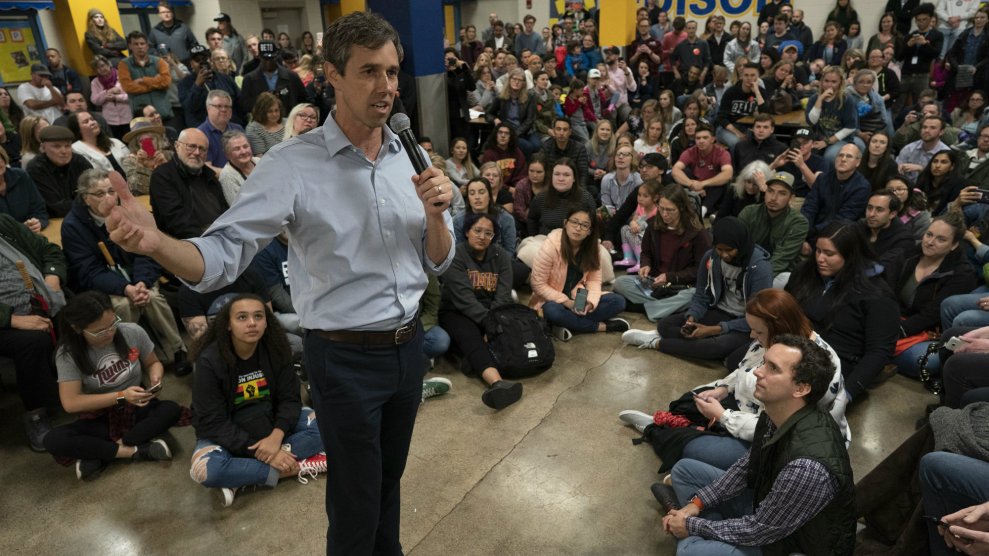
Mario Tama/Getty
This story was originally published by HuffPost and is shared here as part of the Climate Desk collaboration.
At a moment when mounting reports from the world’s top scientists indicate humanity is barrelling toward climate catastrophe and ecological collapse, Democratic presidential candidate Joe Biden is preparing a climate policy that appears to put the United States back on the pre-Trump trajectory.
The former vice president’s proposal is anchored in resetting the clock to 2016 by rejoining the Paris climate accord and reinstating Obama-era regulations on power plant and vehicle emissions, according to a Reuters report published Friday. The policy is expected to maintain a role for fossil fuels, and veer away from the Green New Deal framework that most of Biden’s top rivals for his party’s 2020 presidential nomination have embraced.
“Reheating the Obama administration’s regulations-plus-Paris approach will be totally insufficient,” said Joseph Majkut, a climate scientist and policy expert at the center-right think tank Niskanen Center.
TJ Ducklo, a spokesman for Biden’s campaign, said in an email statement that the former vice president “knows how high the stakes are” and noted his record on addressing climate change.
“As president, Biden would enact a bold policy to tackle climate change in a meaningful and lasting way, and will be discussing the specifics of that plan in the near future,” he said. “Any assertions otherwise are not accurate.”
The descriptions of the forthcoming policy offer only a first glance at Biden’s proposal to address a global crisis that, over the past year, has surged to the top of Democratic primary voters’ concerns. But the position appears dangerously out of step with the United Nations’ Intergovernmental Panel on Climate Change. The world’s leading climate science body warned in October that governments must cut global emission by nearly half and begin removing carbon dioxide from the atmosphere to keep warming from exceeding 1.5 degrees Celsius, or 2.7 degrees Fahrenheit, at which point the havoc wreaked by extreme weather and sea level rise is expected to cost $54 trillion and kill millions.
The finding, confirmed a month later by 13 federal agencies in the congressionally mandated National Climate Assessment, cast a shadow over the Obama administration’s climate legacy. While the 44th president forged the first global emissions-cutting deal to include the United States and China, his administration oversaw the rapid expansion of US oil and gas production, a fact about which Obama boasted last November. Expanded US drilling threatens to add 1,000 coal plants’ worth of greenhouse gases by the middle of the century, according to a January analysis by researchers at more than a dozen environmental groups. That will make the emissions reductions set out by the IPCC all but impossible to meet, and discourage countries like China, India and Indonesia—whose emissions are growing at a rapid clip—from adopting cleaner development strategies as the world’s richest nation and biggest historic emitter fails to set an example.
“The greatest fault in his proposal is the suggestion that natural gas can be part of the solution,” Michael Mann, a climate scientist at Pennsylvania State University, said by email. “The solution to a problem created by burning fossil fuels cannot be the burning of fossil fuels.”
Biden has called climate change an “existential” threat. And during a campaign speech in Iowa earlier this month, he noted that he was “one of the first guys to introduce a climate change bill, way, way back in ’87.” PolitiFact looked into the claim and found it to be true.
Yet, in a speech last month, the former vice president parroted a familiar oil and gas industry line, declaring, “North American energy makes us independent.” And, according to Reuters, he picked Heather Zichal as a climate adviser. Zichal, 42, who advised in the Obama administration, served on the board of liquified natural gas giant Cheniere Energy Partners from 2014 until last year.
Zichal came to Biden’s defense in a post to Twitter on Friday afternoon, saying “Reuters got it wrong.”
I expect as president @JoeBiden would enact a bold policy to tackle climate change in a meaningful and lasting way. Reuters got it wrong. Any suggestion that it wouldn't is in direct contradiction to his long record of understanding climate change as an existential threat.
— Heather Renee Zichal (@hrzichal) May 10, 2019
“There may have been a chance for modest, ‘all of the above,’ ‘middle ground’ climate strategies twenty years ago but we’ve passed that point now,” said Peter Gleick, a climate scientist and co-founder of California’s Pacific Institute. He added that “many politicians still fail to understand or accept the severity of the climate crisis or the speed with which we now have to act.”












